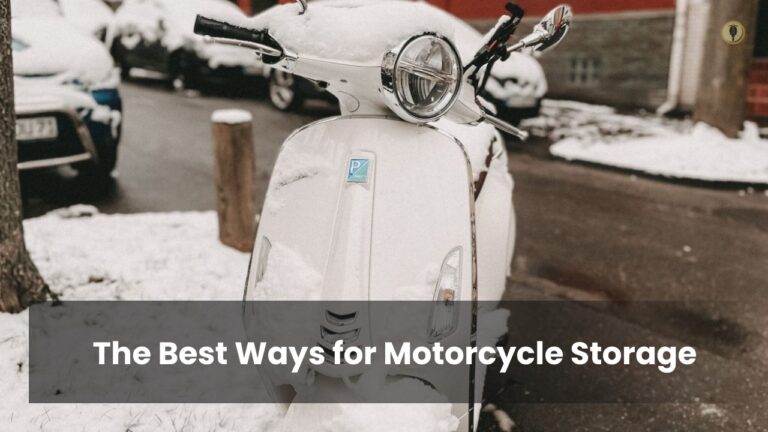Motorcycle storage depends on the owner’s plans. Since motorcycles in storage are inactive, prior thorough preparations are required. Environmental factors are the cause of automotive damages while in storage. Therefore, keeping it in a store for the long-term without proper preparations may cause damages: either winter or summer, oxidation, and fuel.
Degradation will obviously occur in the battery. If the storage is for a long-term plan, regular checkups to add either ethanol or fuel stabilizer are advisable. This article paper gives the best preparations for long-term motorcycle storage tips.
Advantages of Long-term Motorcycle Preparations
Are you in need of preventing oxidation and fuel separation in your motorcycle in the winter? Prior preparations before storage are the key to success. In simple words, oxidation is rusting but sometimes can be a form of white residue on aluminum surfaces.
Oxidation causes brittleness and cracking on rubber materials in the motorcycle. During the winter, coldness accelerates rusting and degradation.
Besides environmental factors, human-motorcycle interference can also affect the motorcycle while in storage. Physical location will also determine the safety of the motorcycle. Crawling animals and insects can interfere with your cherished motorcycle, damage rubber parts, or drop their waste products on metal surfaces.
Time in the Storage
The quality of preparations is dependent on the time you need the motorcycle to stay inactive. Typically, storage time can be up to two weeks, more than two weeks, or up to three months. Three weeks storage is called motorcycle winter storage. Going for rides in Summer or winter and getting your motorcycle out of storage will depend on personal considerations.
Pros and Cons of Using Ethanol in Motorcycle Storage
As technology gains momentum in all sectors, biofuel has recently been a solution to environmental pollution. Ethanol is a biofuel derived from corn. The drawback of using ethanol is that it is hygroscopic, and the constituents separate with time.
The separation leads to a gum that sticks on fuel system parts. On top of all these, ethanol causes tear and wear on motorcycle components. Motorcycle critical components corrode due to absorption of water over time.
In the USA, ethanol gas usage in storage is avoided, and instead, anti-rust fuel products are used. They include a stabilizer, stabil, etc. Pure gasoline is a remedy to problems created by ethanol usage in long-term motorcycle storage. If you need pure gasoline, the USA and Canada are excellent sources.
Depending on the storage time, I have detailed storage tips for different time intervals.
Short Term Motorcycle Storage: Up to Two Weeks
Whether short or long-term storage, the motorcycle should be cleaned before storage. Use wax to cover painted surfaces and all in one cleaner; they work surprisingly great for motorcycles. After cleaning, ignite and run the engine to evaporate the water.
1. Lift the wheels
Without proper knowledge of motorcycle storage, wheels should be off the ground to avoid soil or floor contact. Use a double strand or buy a portable hydraulic lift if you can afford a pretty coin.
The surface in contact with the ground should support the motorcycle for the planned storage time. Avoid parking in the open air due to rains and direct sun. It will be wise to rest the stands on metal plates so that the motorcycle will have firm ground in case of rains.
2. Cover well
It will not hurt if you purchase a cover that suites your motorcycle profile. The cover should allow the motorcycle to breathe and free air circulation. It is recommended to buy one that goes around the motorcycle and covers up to ground level.
3. Battery
The motorcycle battery can stay within the motorcycle without any side effects, but it’s good to connect a charger to provide some power. Before storage, make sure the battery is fully charged up to 12.6V or 14V.
In case the battery has faults, do not use the charging readings to determine its life status. If the problems recur, revisit the entire charging system and solve the faults.
4. Top up with fresh fuel
Ethanol is the best fuel for short-term motorcycle storage. If you can afford gas, you can fill the tank, but for this short period, it is not an essential. The carburetor should be cleaned, dried, and closed. For further tips, consider the user manual.
5. Ethanol-free gasoline vs. gas
For two weeks storage time, ethanol-free oil is not required, but if you can afford gas, the better. Though it is not a requirement, regularly use stabilizer or stabil to avoid carburetor malfunctioning.
6. Security
Security is a key factor in motorcycle storage. If you have a friend who can keep it for you can be a better option.
Motorcycle Winter Storage: 3 months
Since three months is a long time, consider designing a manual for future reference. The funny thing with the manual is that it works in reverse when preparing it out of storage, so be wise.
Cleaning the motorcycle and evaporating the water by running the engine is the first step. Lubricate moving parts, treat chrome and aluminum parts with wax. Lift the motorcycle and place a metal sheet on the stands to avoid direct ground contact.
1. Weather breaks
If the weather is favorable and breaks, you can be tempted to get your motorcycle for a ride. It is not a crime to break the storage plan but be ready to clean it during the cold season or spend a pretty coin on a warm garage.
2. Regular fuel system maintenance
Regular maintenance for filters, carburetor, battery, topping up the fuel tank and changing the oil before storage is mandatory for long-term storage. The motorcycle manual gives guidelines on how to maintain brake fluids, coolants, and hydraulic systems. If you are not competent in dealing with motorcycles, old fluids are either milky, mulky, or different from brand new.
3. Gasoline
Gasoline absorbs moisture from the atmosphere and separates its components. At the bottom of the gas tank settles a milky substance which corrodes it since ethanol is highly reactive.
Pure gasoline is the best alternative, plus the addition of a stabilizer. Draining the fuel system components and stabilizing the remaining fuel is a better idea. If you are not aware of pure gasoline centers, visit puregas.org to track gasoline centers near your area.
4. Rent a storage
Storage dealers offer units for motorcycle storage, and they work surprisingly well. You can either rent a heated or unheated unit depending on the depth of your pocket.
Rented storage comes with guaranteed security and controlled weather conditions. It is not a must to do the preparations while in the storage unit; it can be done at home and drive to the storage location.
5. Heated motorcycle storage
A heated storage unit is best because oxidation is minimized by maintaining a constant temperature. Ventilations in the room should be minimized to reduce the amount of cold air getting in the room. The rate of condensation in the room should be zero.
6. Battery maintenance
The battery should be fully charged, and the acid level monitored. If you can afford a computer-controlled charger, fix it to maintain its lifespan. A fully charged battery reads between 12.6V and 14V.
7. Environmental variation
Environmental changes cause rusting to metal parts. If you choose a heated garage, it should remain heated every time otherwise should remain cold at all times. In simple words, the constant temperature should be maintained. If you rent storage and deflate tyres, be sure that you will get the means to inflate come spring season.
8. Rodents
Rodents are everywhere, and you should not assume. Open ends such as exhaust pipe and steering ends should be closed with woods or steel wool to deter insects from making your motorcycle home.
9. Insurance
Insurance is good in times of misfortunes, but nowadays, insurance companies have noticed the trick used by riders to cancel plans during the winter. The drawbacks outshine the pros because you will lose the entire premiums and 5-star ride discount.
Long-term Motorcycle Storage: Several Years
As the name suggests, long-term storage can run for several seasons. Regular visits to the storage area boost the security and monitor the progress.
1. Checklist
How can I store a motorcycle for the long term? It is an easy-to-do task with this motorcycle storage guideline. Design a checklist and a log to note storage date, progress, and procedure used for preparations. For future references, the checklist can trace the cause of faults if abnormal faults occur.
2. Regular maintenance
Regular replacement of fluids and maintenance of rubber and aluminum surfaces are critical. Change all fluids and filters before storage regardless of the time they were filled.
Clean the motorcycle and coat chrome with wax; painting aluminium parts can do as well. Sun dry to evaporate water in the compartments.
3. Drain the fuel tank
For long-term motorcycle storage, the fuel tank should be drained and free from gasoline. Siphoning can be used to drain the tank. Though pure gasoline is perfect, it breaks down over time, thus causing engine malfunctioning. Adding a stabilizer to the last fuel tank is an extra tip.
4. Consider the battery lifespan
Studies show that a typical battery will have a maximum lifespan of 4 to 7 years, and the performance temperature is 25°C. Basing the study’s argument, batteries depreciate in value over time, but it depends on the storage temperature. Before storage, examine the age of the battery relative to the storage time. You will decide whether to dispose of an old battery or not depending on the remaining time.
5. Cover well
It will not hurt if you invest in a cover that suites your motorcycle profile. The cover should allow the motorcycle to breathe and free air circulation. It is recommended to buy one that goes around the motorcycle and covers up to ground level. The motorcycle should remain dry at all times.
Purchasing a dry battery and adding acid before storage is an alternative. However, dry batteries are less user-friendly. Monitor the charge level by fixing an automatic charger and consider a warm to a cold storage place.
6. Lift the wheels.
Lift the wheels using either a double stand or hydraulic system to avoid direct contact with the ground. Depending on the age of the tyres, purchasing new ones after storage may work. According to tyre manufacturers, the lifespan is five years, and long-term storage will attract new ones.
7. Engine lubrication
Out of all motorcycle parts, the engine is the most critical part. Engine failure sometimes is caused by fogging where oil mist gets into the engine. The remedy to fogging is the use of fogging oil but for a 2-cycle engine. Automatic transmission fuel (ATF) can be applied to the spark plugs. The advantage of ATF is that it does not oxidize to leave deposits. ,
8. Physical space
For long-term motorcycle storage, the physical space chosen should have a constant temperature to avoid condensation. Clear the area around and above the motorcycle, and consider a dry place to rest the stand.
9. Security
Lock up your motorcycle using chains and a cobra link lock if you can afford it. The room should always remain locked and the keys stored by a trusted person. Since the motorcycle is in good condition, invest in digital security measures such as computerized padlocks.
Wrapping it up
Motorcycle storage preparation is directly proportional to the time it will stay in the store. Before thinking of either short, medium, or long-term storage plans, gather enough capital for preparations. Motorcycles in good condition give the rider the best ride of all time, all-terrain. With this guide, all will be well with your motorcycle, and you will save on maintenance costs.

